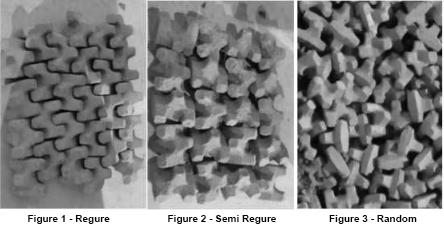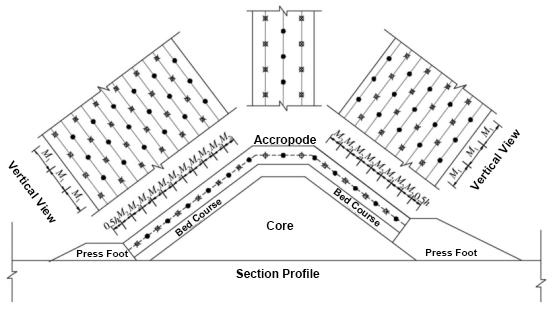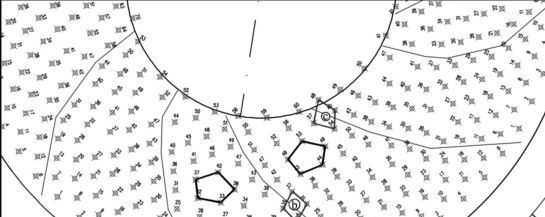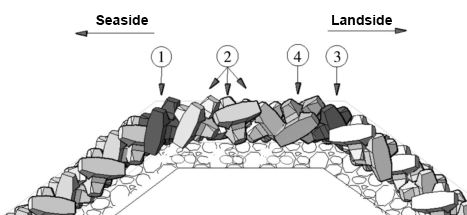In the long-term practical application process of Chinese Accropode, the main placement methods used include regular placement, semi regular placement, and random placement. The actual situation is shown in Figure 1, Figure 2, and Figure 3.

Among them, regular and semi regular placement have low porosity, poor wave dissipation effect, and larger overtopping of the breakwater, requiring a larger number of blocks. Moreover, the instability of a single block can easily cause the entire row of blocks to slip. Compared to this, randomly placed zigzag blocks have advantages such as high porosity, good wave dissipation effect, fewer required blocks, good interlocking effect between blocks, and the minimum stability required for individual blocks. They also have a certain degree of self-healing, that is, after individual zigzag blocks become unstable, the remaining zigzag blocks will gradually compact and form a stable protective layer under wave action. Due to the complexity of the rules for random placement, the level of understanding by engineering technicians of the rules for random placement of diagonal blocks will directly affect the overall construction quality of diagonal block protection. Below is a further explanation of "random placement".
Random Placement
Random placement "can easily cause misunderstandings for engineering personnel, and its full name should be expressed as" random placement at a fixed point ". The placement point of the torsion block is required, but its posture is required to be random. As shown in Figure 4, on a flat sloping surface, the placement position of the torsion block is arranged in a regular diamond shape.

Tips of Random Placement
1 Basic requirements for random placement
The ultimate goal of installing the Accropodes is to form a stable protective layer, so when placing the Accropodes, the following basic principles need to be followed:
1) The placement density, as the most important control indicator for the blocks, needs to comply with the relevant requirements of the specification.
2) As a single layer placed block, the Accropode is not allowed to protrude beyond the protective layer by more than 1/3 of the block height, and each block needs to be in contact with the cushion layer.
3) Any block needs to be in contact with other blocks to maintain tightness. The block in the upper layer should span between the two blocks in the lower layer, and excessive bias is not allowed, even if the upper block is only supported on the lower block.
4) The gap between the blocks should not be too large to avoid the leakage of cushion stones from the gaps between the blocks.
5) The orientation of the block needs to be different, and try to avoid using the same posture. The number of adjacent blocks with the same posture shall not exceed 3.
6) All blocks should be placed in a three-point landing mode, and single or two-point landing is strictly prohibited.
7) When the circular section or turning band of the embankment head is placed, because the radius at the toe of the embankment is larger than that at the top of the embankment, as the accropode is placed closer to the top of the embankment, its distribution diamond grid gradually deforms. In some areas, even if the remaining space is too small, it is difficult to place a complete accropode block, the accropode block at this location will have to be discarded to form an irregular Pentagon (as shown in Figure 5). Although it is allowed to abandon the block locally, this irregular Pentagon layout should be avoided continuously during construction.

2 Placement order
Placement on an inclined plane: From the foot of the embankment to the top of the embankment, one by one, starting from water and then land, and proceeding from bottom to top. When conditions are met, the placement of the protective layer can be carried out at multiple points simultaneously, and the initial placement position should be selected in the area where the axis of the breakwater is relatively smooth and the wave force is small.
Embankment top installation: After the blocks on both sides of the breakwater are completely installed, the installation of the embankment top can begin. There is no specific point position requirement for the placement of the horizontal section of the accropode block. During the placement process, it is only necessary to ensure that all blocks are in close contact and reach the maximum placement density. From the cross-sectional view (Figure 6), it can be seen that during construction, the blocks in part ① of the sea slope and the horizontal section should be placed first, followed by the blocks in part ② towards the land side, followed by the blocks in part ③ that intersect the land slope and the horizontal section, and finally the blocks in part ④ to connect the blocks on both sides.

To ensure that the breakwater truly plays a protective role in the dam, it is advisable to choose a fixed point random placement method as much as possible. During construction, it is necessary to fully understand the random placement and pay attention to preventing potential problems, which can achieve the best bite effect, reduce the wave climbing height, and help to leverage the excellent hydrodynamic performance of the accropode block, thus forming a stable, efficient, and economical protective layer structure.
Ningbo Xiaolang Construction Engineering Co., Ltd.
Ningbo Tianyuan Cement Products Co., Ltd.
Yuehu Ginza, Nanzhan East Road, Haishu District, Ningbo City
+86 574 8698 8331
315012


Copyright © Ningbo Tianyuan Construction Engineering Co., LTD All Rights Reserved | Sitemap
